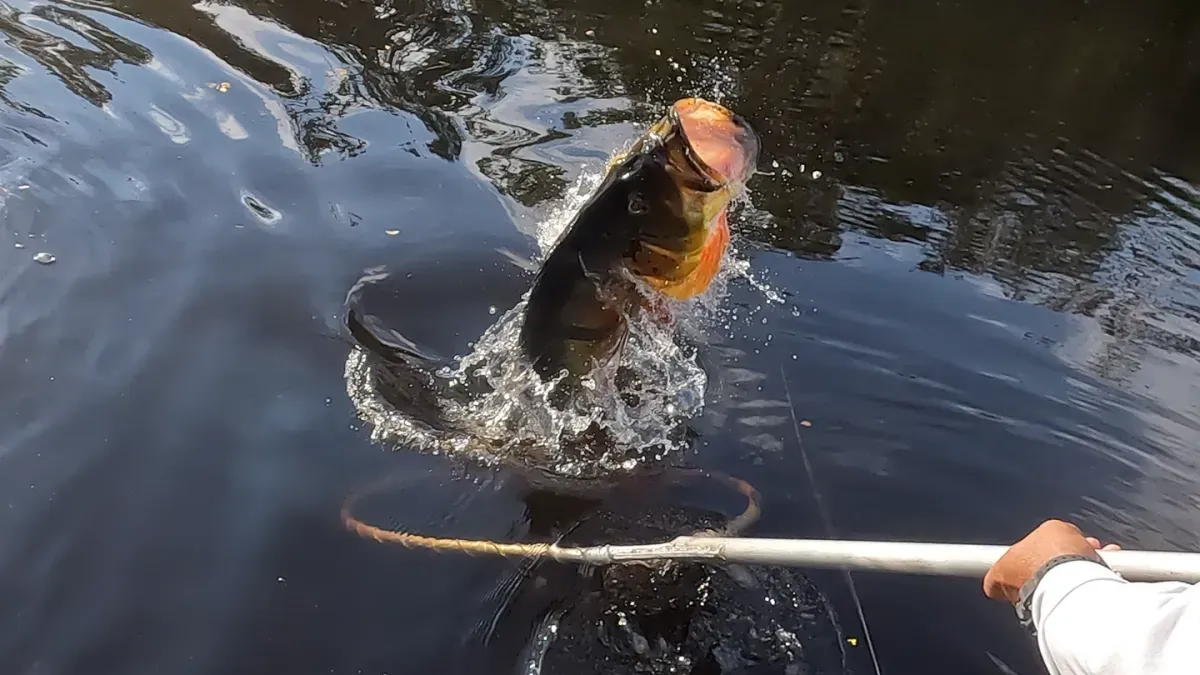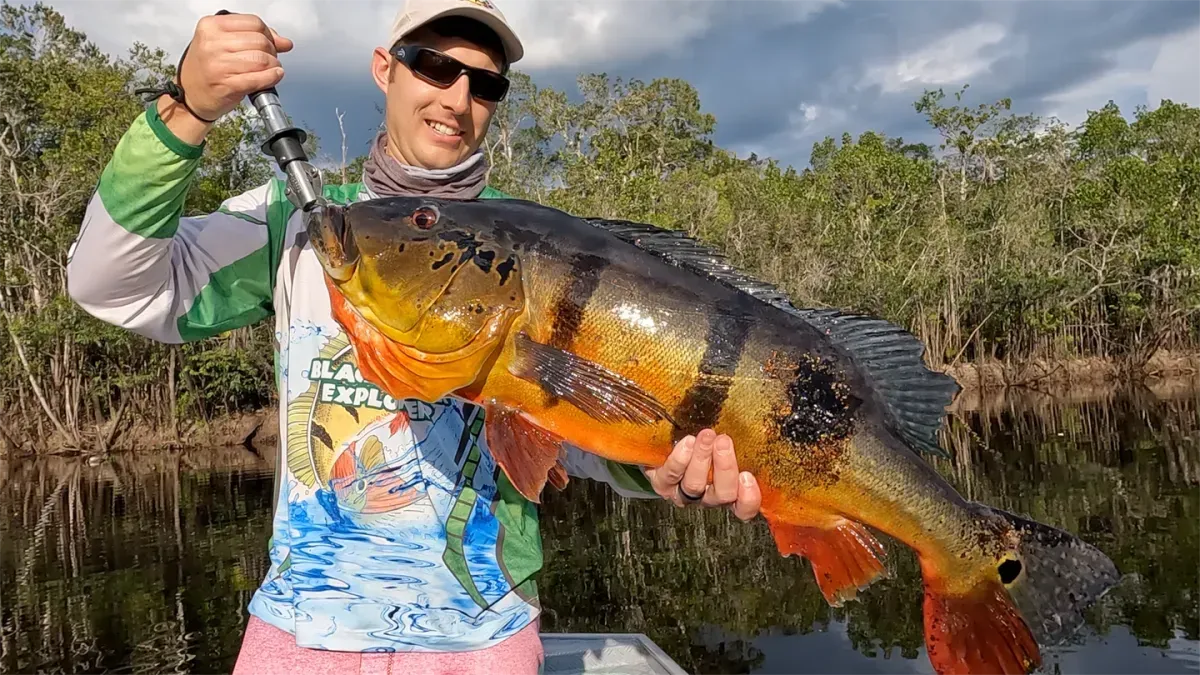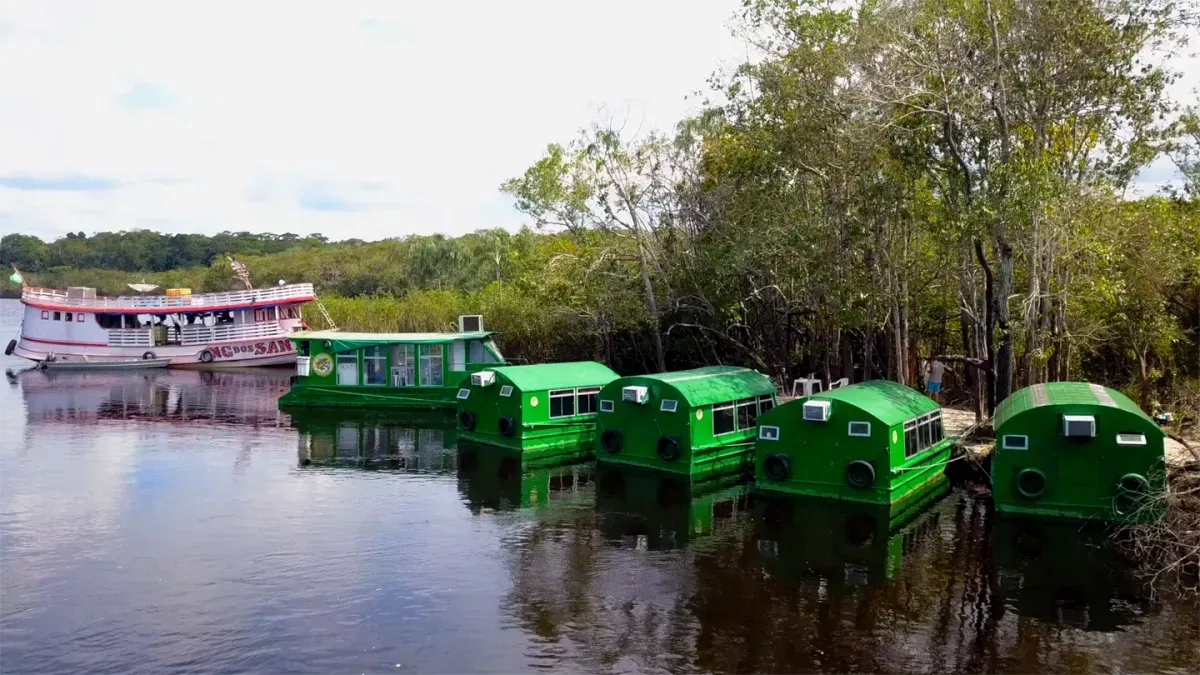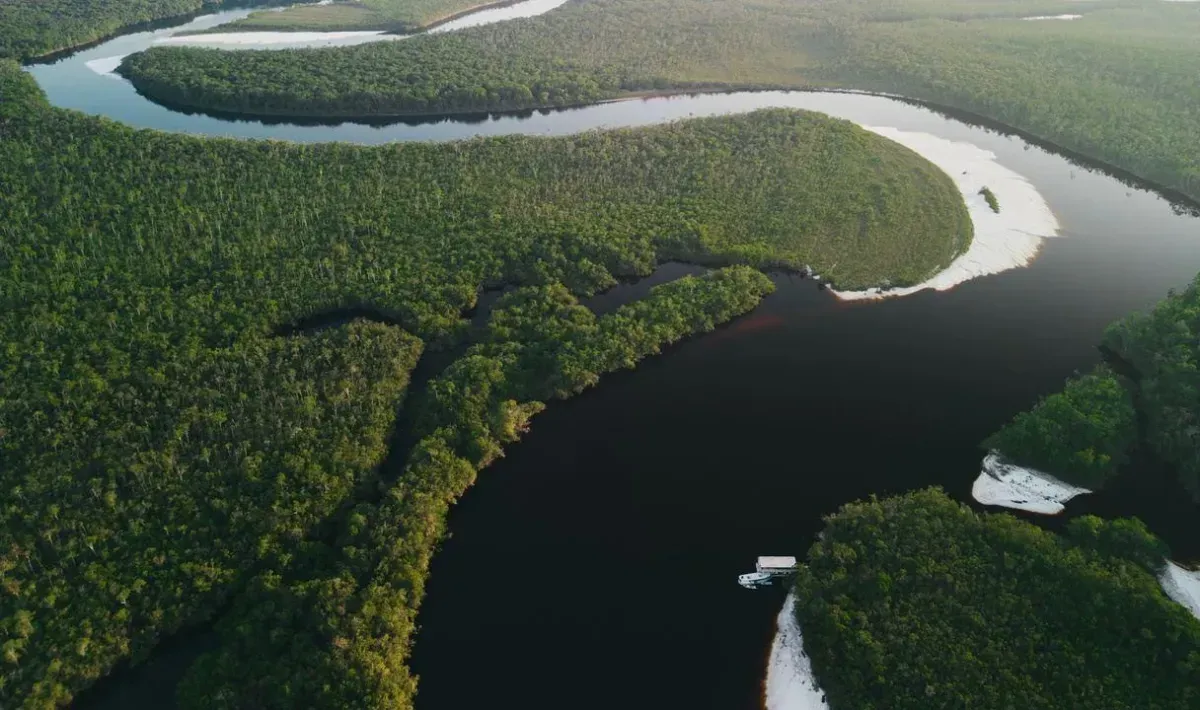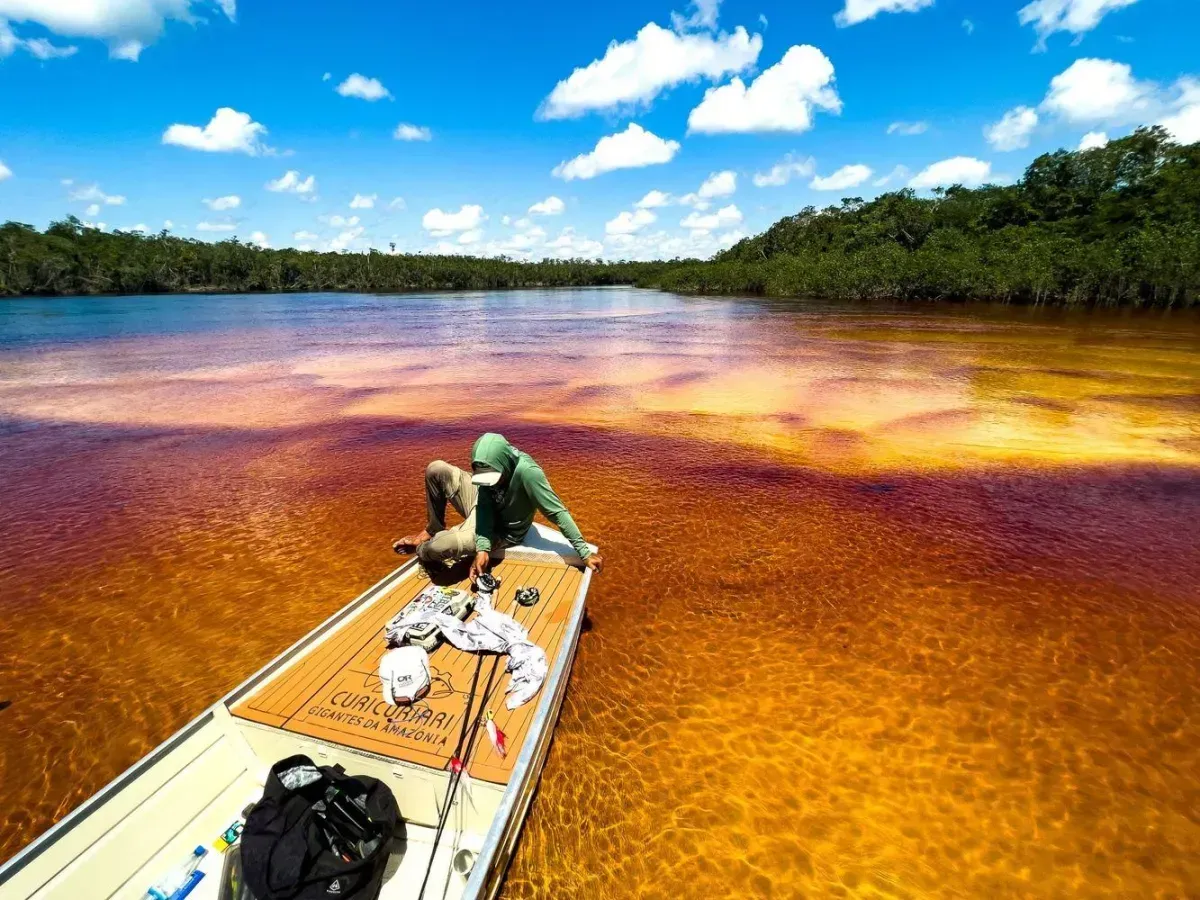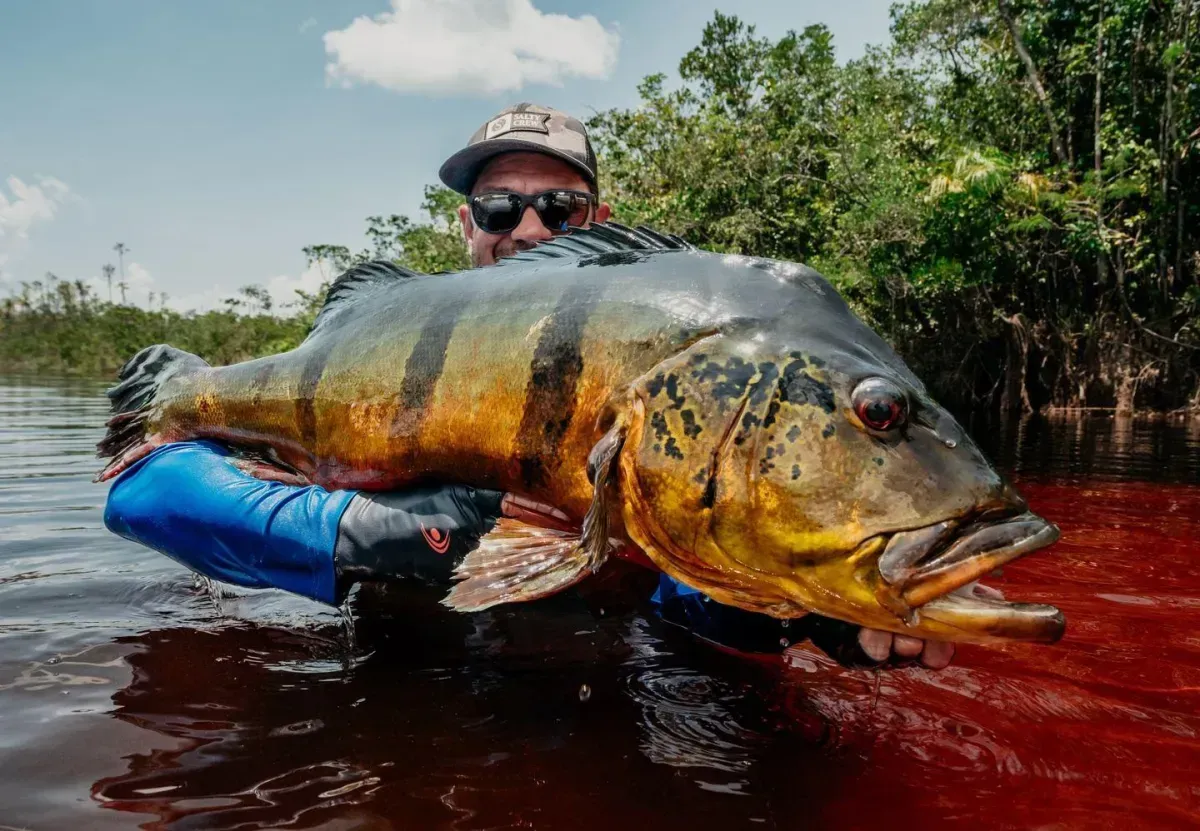Peacock Bass Fishing in the
Amazon Rainforest

Explore South America's most thrilling freshwater fishery
Peacock bass are the most exciting gamefish in the Amazon—and among the most aggressive in the world. Found in the Rio Negro basin and its countless tributaries, these powerful cichlids are known for their explosive strikes, stunning colors, and relentless fights.
The largest of the species, the Temensis, dominates these Rio Negro waters, and two smaller species of Peacock Bass, the Orinocensis and Monoculus, add to the fun and variety of the Peacock Bass fishing.
Together, these three species dominate the region’s blackwater lagoons, hidden creeks, and flooded forests, creating a fishery unlike any other on Earth. Whether you're an experienced angler or new to jungle fishing, there’s no better place to chase action-packed days on the water than the Amazon.
Our Peacock Bass
Adventures at a Glance
Floating Bungalows
Mobility Meets Maximum Access
These fly-in, mobile floating cabins are designed to move with water levels, placing anglers directly in the most productive headwaters and hidden creeks in the Rio Negro tributaries. With just eight anglers per week, you’ll fish in secluded zones few others reach—catching both quantity and quality peacock bass in unpressured waters. Each bungalow features A/C, a private bathroom, and cozy beds for an immersive but comfortable jungle experience.
Floating Bungalows
This trip provides a great chance at large peacock bass in an intimate jungle setting. These floating bungalows can take you to the most inaccessible headwaters regions.
Remote Waters, Refined Experience
Blackwater EXPLORER
Remote Waters, Refined Experience
The most consistent fishing trip in the Amazon! This beautiful yacht roams the enormous Rio Negro basin from mid-October through February, concentrating on accessing productive waters.
With hundreds of miles of complex, island-dotted archipelagos and dozens of fish-laden tributaries, this is the world's largest peacock bass fishery – and the Explorer is built to take advantage of it.
Floating Bungalows
This trip provides a great chance at large peacock bass in an intimate jungle setting. These floating bungalows can take you to the most inaccessible headwaters regions.
Blackwater EXPLORER
Remote Waters, Refined Experience
The most consistent fishing trip in the Amazon! This beautiful yacht roams the enormous Rio Negro basin from mid-October through February, concentrating on accessing productive waters.
With hundreds of miles of complex, island-dotted archipelagos and dozens of fish-laden tributaries, this is the world's largest peacock bass fishery – and the Explorer is built to take advantage of it.
Curicuriari
Trophy Class Peacock Bass
This remote location on the Curicuriari River is a lightly fished tributary with a growing reputation for producing some of the biggest peacock bass in the Amazon. If you’re aiming for a peacock bass world record or a shot at your personal best, this is the place. Anglers often encounter Cichla temensis over 20 pounds in these secluded waters. You’ll stay in a boutique setting with air-conditioned suites, excellent food, and a serious focus on trophy fish.
Despite their name, peacock bass aren’t bass at all—they’re part of the cichlid family, known for their strength, speed, and territorial aggression. They display an astonishing range of color and pattern variations, from deep vertical bars to vibrant red fins and glowing gold flanks. And while their beauty is remarkable, it’s their behavior that truly sets them apart. These fish will smash topwater lures without hesitation, erupt from the water in wild leaps, and challenge even the best anglers to land them. It’s no exaggeration to say that every cast in these waters can lead to a memorable fight.
Acute Angling’s trips are strategically timed to fish the Rio Negro basin and the Curicuriari River during low-water conditions—when peacock bass are most concentrated and active. This seasonal pattern is the key to success. When the water drops and baitfish leave the flooded forest, peacock bass follow them into fishable lagoons and channels. That’s when we move in. Our deep knowledge of Amazon water cycles, along with mobile fishing platforms, lets us stay on productive waters while others are left behind. Whether you're after sheer numbers, solid quality, or the possibility of connecting with a fish of a lifetime, Acute Angling puts you in the best position to succeed.
These are dedicated peacock bass fishing trips, focused on high-action. We provide the conventional tackle, the guides, the logistics, and the accommodations—all you have to do is show up ready to fish. Whether you’re drawn to the fast-paced action of dozens of hard-fighting fish per day, or you’re hoping to land a record peacock bass, Acute Angling has the Amazon experience that fits your goals. With our long track record of excellence, high return-angler rate, and deep regional expertise, we offer the most complete way to fish peacock bass in South America.
TESTIMONIALS
What others are saying
"There is not a better outfit to go peacock bass fishing with than Acute Angling. They are first class all the way. From start to finish they take great care of you and leave nothing to chance…My expectations for this trip were high and they exceeded that. I guess the best compliment I can give them is I’ve already booked two future trips with them."
- Ashley P.

"The guides and all of the Acute Angling staff are the best. Peacock Bass are in a league of their own! If this is on your check-list, JUST DO IT, you will not be disappointed!"
- T.

“This was one of the best trips I’ve ever been on!...The management made the whole process very easy and provided a ton of info for us leading up to the trip. I honestly can’t rave enough about it. My dad already has another trip booked with them and I will definitely be booking with them in the future on one of their other trips as well. 10/10 experience.”
- Bannon G.

Join Us: Get monthly newsletters, discount offers and new content notifications exclusively for our members. Join for FREE below with your name and email.
Join Us: Get monthly newsletters, discount offers and new content notifications exclusively for our members. Join for FREE below with your name and email.
Read Our Newest Blogs
Lorem ipsum dolor sit amet, consectetur adipiscing elit. Aliquam

20 Pound Peacock Bass
A 10-pound peacock is a nice fish, a 15-pounder is large, and 20+ is a special trophy.
Due to our digital world, anglers are bombarded with pictures of big fish and carefully-crafted ads that make it seem like everyone will catch a peacock bass worthy of a magazine cover. However, that just isn’t reality. The reason a 20-pounder is a trophy fish is because it isn’t easy to catch.

To clarify, we set our standard according to what IGFA considers to be a trophy peacock bass. In order to qualify for their Trophy Fish Club the Peacock must be 9.1 kg (20 lb) or 86 cm (33.9 in).
Generally those who catch the trophy-size peacocks are dedicated anglers who have fished in the Amazon several times. It's also likely these anglers have experienced the heartache of losing a massive fish on previous trips or had a trip with less than ideal weather or water levels. They push through these adversities and become a student of Amazon fisheries.
Most often these anglers are the most prepared for their trip. They pack the right clothing, practice their casting before leaving home, study relevant information online, and chat and share fishing tips with other traveling anglers.

They will be up in the morning and ready to leave as soon as the guide says it is safe. They fish as long as their body permits, and they focus on each cast like a professional basketball player focuses on a free throw. They know each cast and inch of accuracy is important.
Truth be told, pursuing a 20-pounder requires an angler to be competitive with themself.
Of course there is the occasional angler who shows up on the first trip and lands a trophy, but the majority of trophy pursuers have to put in the effort and time to catch their wall hanger. Luck is nice to have, but anglers who are experienced and talented tend to create their own luck.

There are a few things anglers can do to increase their chances of landing one of these memorable fish:
Practice your casting before you come to the Amazon. Practice with lures in the ½-1½ ounce range. Use 50-65 pound braid to mimic the line used in the Amazon. Take the hooks off a few lures and dedicate 10 minutes a day in the backyard or at a local park a couple weeks before you show up. It will make a huge difference when you arrive.
Fish rivers with a higher concentration of trophy fish (for example, the Curicuriari). There are certain rivers in the Amazon that produce more trophy peacock bass than others. Be aware that many of these rivers actually have a lower quantity of fish compared to the main Rio Negro.
Prepare yourself for the elements. I’m always surprised how many anglers show up to the largest rainforest in the world without a rain jacket. Also, every season we have a few stubborn anglers who wear little-to-no sunscreen because they claim they are used to it from the Texas or Florida sun. They spend the next fishing day at the accommodations soaking in aloe vera. Ten hours a day on the water takes a toll on your body anywhere, but one should be especially careful in a tropical rainforest. Keeping powder electrolytes in your day bag is a good idea to keep you hydrated.

Take care of yourself during the trip. Eat at each meal, take a break from the sun and rest in the shade at least once or twice a day. Drink lots of water and go to bed early. If you want to stay up and drink with your friends that is fine. It is your trip and there is nothing wrong with enjoying your trip the way you want. However, it is obvious that the angler who is well-rested, has clarity of mind, and is on the water early is going to greatly increase the chance of landing a trophy.
When you hook into a big one, try not to panic and immediately attempt to force the fish to the boat. Big peacocks have the ability to make lines scream off the reel. Before you know it they bolt for the jungle and get your line tangled in a web of submerged branches and trees. After the initial hook set, reel quickly to make sure the line is tight and then make one more good hook set to ensure a good connection. After that try to relax and make steady and controlled movements. If you try to force the fish in as fast as you can the big peacock will most likely bolt and head for submerged cover.
Explaining the fighting technique is difficult through the written word, so look up largemouth bass anglers reeling in bass on YouTube. Then watch anglers fishing for tarpon and snook specifically in mangroves. The example of what not to do when trying to land a big peacock bass is crank on the reel as fast as you can like the largemouth bass fishermen. Instead, mimic the Snook and Tarpon fishermen in the mangroves. Pay attention to how the mangrove angler applies pressure with the rod and how the guide assists by slowly backing the boat away from the mangroves. The rod, drag, and positioning of the boat are all used to tire the fish and bring it to the boat steadily.Stay focused by imagining a target. When fishing, imagine a tennis ball floating in the spot you want your lure to land, then cast it to that imaginary tennis ball. If you see a nice pocket, imagine a smaller target (like a ping pong ball) within that pocket and cast to that. Having this smaller target greatly increases casting accuracy. If you don’t laser in on smaller targets, casting gets sloppier.

In summary, anglers who catch trophy peacock generally have some peacock bass fishing experience under their belt, they practice and prepare before their trip, and they focus when they arrive on their trip. Also, it never hurts to have some luck when fishing for trophies so maybe bring that lucky fishing hat. 🙂
Sources:

(866) 832-2987

